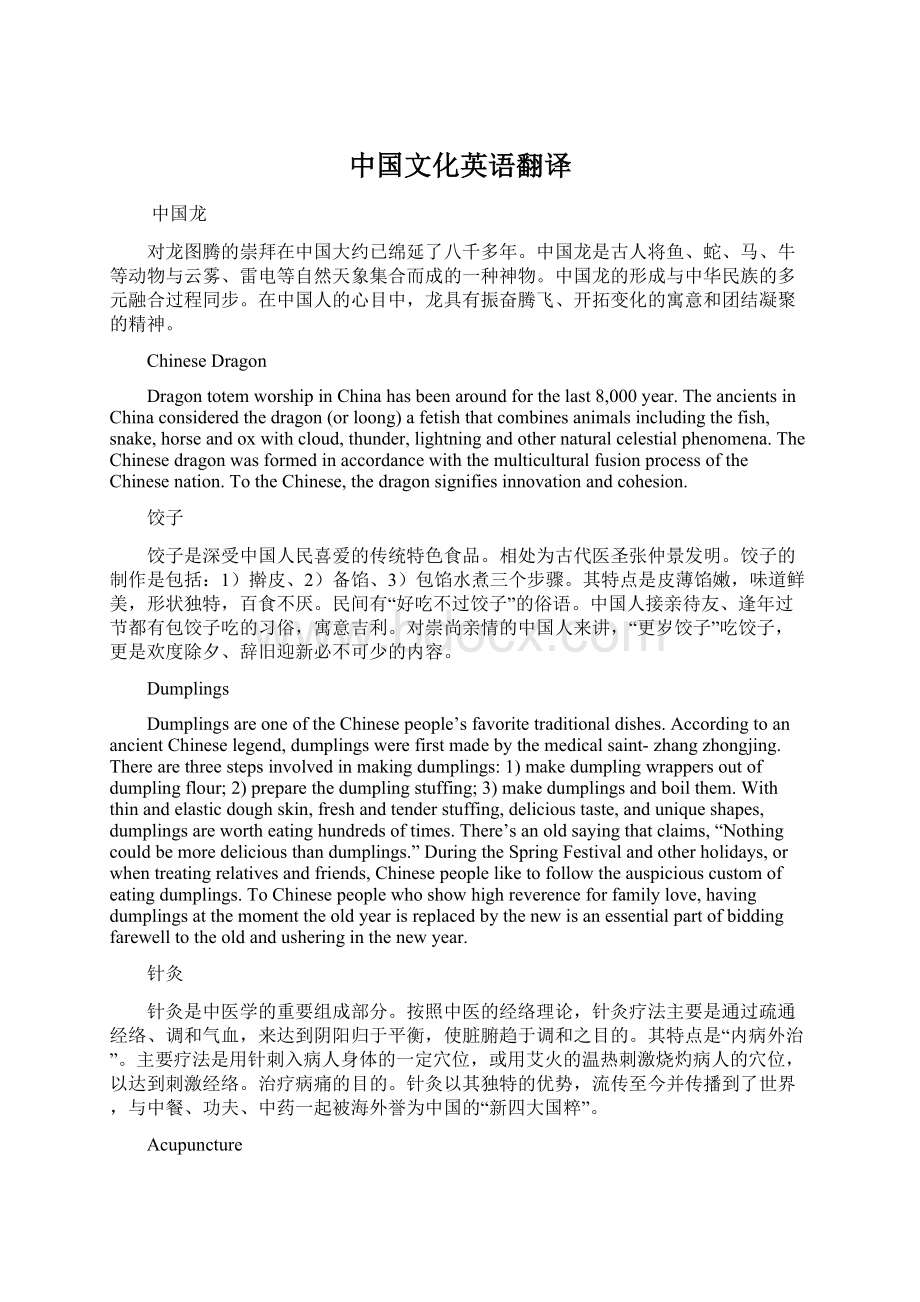中国文化英语翻译.docx
《中国文化英语翻译.docx》由会员分享,可在线阅读,更多相关《中国文化英语翻译.docx(13页珍藏版)》请在冰豆网上搜索。

中国文化英语翻译
中国龙
对龙图腾的崇拜在中国大约已绵延了八千多年。
中国龙是古人将鱼、蛇、马、牛等动物与云雾、雷电等自然天象集合而成的一种神物。
中国龙的形成与中华民族的多元融合过程同步。
在中国人的心目中,龙具有振奋腾飞、开拓变化的寓意和团结凝聚的精神。
ChineseDragon
DragontotemworshipinChinahasbeenaroundforthelast8,000year.TheancientsinChinaconsideredthedragon(orloong)afetishthatcombinesanimalsincludingthefish,snake,horseandoxwithcloud,thunder,lightningandothernaturalcelestialphenomena.TheChinesedragonwasformedinaccordancewiththemulticulturalfusionprocessoftheChinesenation.TotheChinese,thedragonsignifiesinnovationandcohesion.
饺子
饺子是深受中国人民喜爱的传统特色食品。
相处为古代医圣张仲景发明。
饺子的制作是包括:
1)擀皮、2)备馅、3)包馅水煮三个步骤。
其特点是皮薄馅嫩,味道鲜美,形状独特,百食不厌。
民间有“好吃不过饺子”的俗语。
中国人接亲待友、逢年过节都有包饺子吃的习俗,寓意吉利。
对崇尚亲情的中国人来讲,“更岁饺子”吃饺子,更是欢度除夕、辞旧迎新必不可少的内容。
Dumplings
DumplingsareoneoftheChinesepeople’sfavoritetraditionaldishes.AccordingtoanancientChineselegend,dumplingswerefirstmadebythemedicalsaint-zhangzhongjing.Therearethreestepsinvolvedinmakingdumplings:
1)makedumplingwrappersoutofdumplingflour;2)preparethedumplingstuffing;3)makedumplingsandboilthem.Withthinandelasticdoughskin,freshandtenderstuffing,delicioustaste,anduniqueshapes,dumplingsarewortheatinghundredsoftimes.There’sanoldsayingthatclaims,“Nothingcouldbemoredeliciousthandumplings.”DuringtheSpringFestivalandotherholidays,orwhentreatingrelativesandfriends,Chinesepeopleliketofollowtheauspiciouscustomofeatingdumplings.ToChinesepeoplewhoshowhighreverenceforfamilylove,havingdumplingsatthemomenttheoldyearisreplacedbythenewisanessentialpartofbiddingfarewelltotheoldandusheringinthenewyear.
针灸
针灸是中医学的重要组成部分。
按照中医的经络理论,针灸疗法主要是通过疏通经络、调和气血,来达到阴阳归于平衡,使脏腑趋于调和之目的。
其特点是“内病外治”。
主要疗法是用针刺入病人身体的一定穴位,或用艾火的温热刺激烧灼病人的穴位,以达到刺激经络。
治疗病痛的目的。
针灸以其独特的优势,流传至今并传播到了世界,与中餐、功夫、中药一起被海外誉为中国的“新四大国粹”。
Acupuncture
AcupunctureisanimportantpartoftraditionalChinesemedicine(TCM).Inaccordancewiththe“mainandcollateralchannels”theoryinTCM,thepurposeofacupunctureistodredgethechannelandregulateqiandblood,soastokeepthebody’syinandyangbalancedandachievereconciliationbetweentheinternalorgans.ItfeaturesintraditionalChinesemedicinethat“internaldiseasesaretobetreatedwithexternaltherapy”.Themaintherapyofacupunctureinvolvesusingneedlestopiercecertainacupointsofthepatient’sbody,oradoptingmoxibustiontostimulatethepatient’sacupointssoastostimulatethechannelsandrelievepain.Withitsuniqueadvantages,acupuncturehasbeenhandeddowngenerationaftergenerationandhasnowspreadallovertheworld.Nowadays,acupuncture,alongwithChinesefood,kungfu(otherwiseknownasChinesemartialarts),andtraditionalChinesemedicine,hasbeeninternationallyhailedasoneofthe“fournewnationaltreasures.”
中国武术
中国功夫即中国武术,是将技击寓于搏斗和套路运动之中的中国传统体育项目,承载着丰富的中国民族传统文化。
其核心思想是儒家的中和养气之说,同时兼容了道家、释家的思想。
中国武术源远流长、流派林立、拳种繁多,讲究刚柔并济、内外兼修,蕴含着先哲们对生命和宇宙的参悟。
后世所称十八般武艺,主要指:
徒手拳艺,如太极拳、形意拳、八卦掌等;器械功夫,如刀枪剑戟、斧钺钩叉等。
ChineseKungFu
Chinesekungfu,orChinesemartialarts,carriestraditionalChinesecultureinabundance.ItisatraditionalChinesesportwhichappliestheartofattackanddefenceincombatandthemotionsengagedwithaseriesofskillandtricks.ThecoreideaofChinesekingfuisderivedfromtheConfuciantheoryofboth“themeanandharmony”and“cultivatingqi”(otherwiseknownasnourishingone’sspirit).Meanwhile,italsoincludesthoughtsofTaoismandBuddhism.Chinesekungfuhasalonghistory,withmulti-varioussectsandmanydifferentboxingstyles,andemphasizescouplinghardnesswithsoftnessandinternalandexternaltraining.Itcontainstheancientgreatthinkers’ponderingoflifeandtheuniverse.Theskillsinwieldingthe18kindsofweaponsnamedbythelatergenerationsmainlyinvolvetheskillsofbare-handedboxing,suchasshadowboxing(Taijiquan),formandwillboxing(Xingyiquan),eighttrigrampalm(Baguazhang),andtheskillsofkungfuweaponry,suchastheskillofusingswords,spears,two-edgedswordsandhalberds,axes,tomahawks,kooks,prongsandsoon.
中国汉字
汉字是从原始人用以记事的简单图画,经过不断演变发展最终成为一种兼具音、形、意、韵的独特文字。
现存中国古代最早成熟的文字是甲骨文,被认为是现代汉字的初形。
此后,汉字又经历了金文、隶书、楷书、草书、行书等不同的阶段。
汉字结构“外圆内方”,源于古人“天圆地方”的观念。
汉字有五种基本笔画,即:
横、竖、撇、捺、折。
ChineseCharacters
Chinesecharacterswereinitiallymeanttobesimplepicturesusedtohelppeoplerememberthings.Afteralongperiodofdevelopment,itfinallybecameauniquesystemthatembodiesphoneticsound,image,idea,andrhymeatthesametime.Thewritingsystem,whichwasextremelyadvancedinancienttimes,beganwithinscriptionsontortoiseshells,andtheseareregardedastheoriginalformsofChinesecharacters.Afterwards,Chinesecharacterswentthroughnumerouscalligraphicstyles:
bronzeinscriptions,officialscript,regularscript,cursivescript,runningscript,etc.Chinesecharactersareusuallyroundoutsideandsquareinside,whichisrootedinancientChinesebeliefsofanorbicularskyandarectangularEarth.ThefivebasicstrokesofChinesecharactersare“—”(thehorizontalstroke),“︱”(theverticalstroke),“丿”(theleft-fallingstroke),“丶”(theright-fallingstroke),and“乙”(theturningstroke).
中国筷子
中国人使用筷子就餐的方式在世界上独树一帜。
有史记载用筷的历史已有三千多年。
筷子古时称为箸,它看似简单,但却同时具有夹、拨、挑、扒、拌、撮、戳、撕等多种功能。
中国民间视筷子为吉祥之物,如婚俗中将筷子隐喻为快生贵子的祝福等。
与使用刀叉以及手抓的方式不同,成双结对的筷子含有“和为贵”的意蕴。
西方人赞誉筷子是古老的东方文明。
ChineseChopsticks
TheChinesewayofeatingwithchopsticksisuniqueintheworld.Therecordedhistoryofchopsticksstartedmorethanthreethousandyearsago.ChopstickswerenamedzhuinancientChinese.Theylookdeceptivelysimpletouse,butpossessmulti-variousfunctions,suchasclamping,turningover,liftingup,raking,stiring,scooping,poking,tearing,andsoon.ChopsticksweretakenasanauspiciousmascotbyordinarypeopleinancientChina.Forexample,thepartialtoneofchopsticksisoftenusedbypeopleasametaphorasweddingstoindicateablessingorbenedictionforthecoupletohaveababysoon.Unlikeusingaknifeandforkorone’sownhands,apairofchopsticksalsoimpliesthemeaningof“Harmonyiswhatmatters.”ChopsticksarehighlypraisedbyWesternersasahallmarkofancientorientalcivilization.
Unit7ChineseSeal
Asealcanalsobedefinedasastamp.BoththeChineseofficialandprivatesealofvariousdynastieshavedifferenttitles,suchasstamp,zhunote,contract,fu,leaseandothers.ThesealsusedbytheemperorsofancientChinawerecalledxi,yin,bao,etc.Accordingtohistoricalrecords,sealswerewidelyusedduringtheWarringStatesPeriod(475BC-221BC).Themakingofasealistoengravefonts,suchassealcharactersandofficialscriptandsoon;orimagesintheformofintaglioandembossmentintotheseal,basicallyshapedasroundorsquare.Coveredwithavermilionoverlay,theChinesesealisnotonlyusedindailylife,butitisalsousedtorepresentsignaturesonpaintingsandcalligraphies.ItisgraduallybecomingoneofChina’suniqueartworks.
印章就是图章。
中国历代官、私所用的印章有印信、朱记、合同、符、契等等不同的称谓,而帝王所用的印章古时称玺、印、宝、章等。
据史料记载,印章在战国时代已普遍使用。
印章的制作是将篆隶等字体、图像用阴、阳的形式雕刻而成,形状以圆、方为主。
印章用朱色钤盖,除日常应用外,又多用于书画题识,逐渐成为中国特有的艺术形式之一。
Unit8ChineseEra
TheChineseeraisthesymbolthattheChinesecalendarusesforrecordingandnamingyears.ThetenHeavenlyStemsare:
jia,yi,bing,ding,wu,ji,geng,xin,ren,gui.ThetwelveEarthlyBranchesare:
zi.chou,yin,mou,chen,si,wu,wei,shen,you,xu,hai.Afterobservingthelunarmonth,theancientsfoundthatthemoonalwayswazesandwanesroughly12timesayear,andtwolunarmonthsaccountforabout60days,sotheorderofthetenHeavenlyStemsandtheorderofthetwelveEarthlyBranchesareproperlymatchedinturn.Intermsofrecordingdate,60yearsisconsideredtobeafulltimecycle.TheChineseerachronologywasfirstinventedinancienttimesandisstillinusenow.accordingtothechronologyofthe“tenHeavenlyStems,”2011istheyearof“theseventhofthetenHeavenlyStems”and“thefifthofthetwelveEarthlyBranches”.
天干地支是中国历法中用以记录和命名年岁的方法。
十天干为:
甲、乙、丙、丁、戊、已、庚、辛、壬、癸;十二地支为:
子、丑、寅、卯、辰、巳、午、未、申、酉、戊、亥。
古人观测朔望月,发现月亮圆缺12次大体上是一年的天数,而两个朔望月约是60天。
古人以十天干与十二地支的顺序依次相配,记录不同年份,60年为一个轮回。
干支纪年法从古沿用至今。
按干支纪年法,2011年便是辛卯年。
中国丝绸
中国是丝绸的故乡。
栽桑、养蚕、缫丝、织绸是中国古代人民的伟大发明。
商周时期(前1600—前256)丝绸的生产技术就已经发展到相当高的水平。
西汉(前206—公元25)时张骞通西域,把中原与波斯湾、地中海紧密联系起来,开辟了中外交流贸易的新纪元。
从此中国的丝绸以其卓越的品质、精美的花色和丰富的文化内涵闻名于世,成为中国文化的象征、东方文明的使者。
Chinaisthehomeofsilk.Mulberryplanting,sericulture,silkreelingandthickeningareallgreatinventionsoftheancientChinese.AsearlyastheShangandZhouDynasties(1600BC—256BC),theChinesepeople’ssilk-weavingtechniqueshadreachedanextremelyhighlevel.DuringtheWesternHanDynasty(206BC—25BC),ZhangQian,anoutstandingdiplomat,traveledaroundcentralAsiaandconnectedChinawiththePersianGulfandtheMediterranean,openingupaneweraofSino-foreigntrade,exchangeandcommunication.Fromthenon,China’ssilkbecamewellknownforitsextraordinaryquality,exquisitedesignandcolor,andabundantculturalconnotations.Hitherto,ChinesesilkhasbeenacceptedasasymbolofChinesecultureandtheemissaryoforientalcivilization.
中国园林
中国园林是把人造的山水、植物、建筑等与自然地貌有机结合的环境艺术,是我国古代建筑艺术的珍宝。
其建造原则是“妙极自然,宛自天开”。
游赏中国古典园林,能充分领略“假自然之景,创山水真趣”的园林意境。
在世界三大园林体系中,中国园林历史悠久、内涵丰富,被誉为世界造园史上的渊源之一。
TheChineseClassicalgardenisaprecioustreasureofourancientChinesearchitecture.Itisakindofenvironmentalart,whichsystematicallycombinesartificialmountainsandrivers,plantsandbuildingswiththenaturallandscape.TheconstructionstandardofaChineseclassicalgardenis“artificialasitis,thegardenmustlookingeniousandnatural.”WhenyougosightseeinginaChineseclassicalgarden,youshouldbeabletoappreciateitsartisticconceptwhich“makesuseofthenaturallandscapetocreate